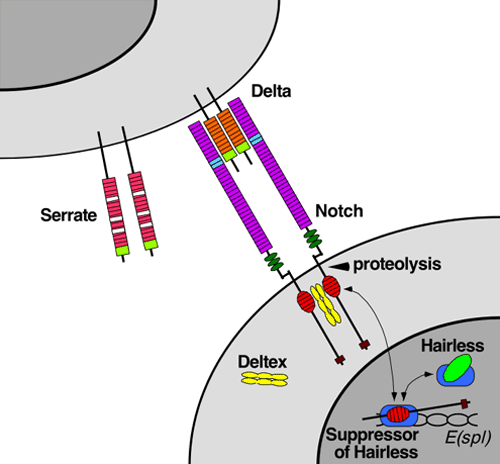
Juxtacrine signalling
Encyclopedia

Cell signaling
Cell signaling is part of a complex system of communication that governs basic cellular activities and coordinates cell actions. The ability of cells to perceive and correctly respond to their microenvironment is the basis of development, tissue repair, and immunity as well as normal tissue...
that is transmitted via oligosaccharide
Oligosaccharide
An oligosaccharide is a saccharide polymer containing a small number of component sugars, also known as simple sugars...
, lipid
Lipid
Lipids constitute a broad group of naturally occurring molecules that include fats, waxes, sterols, fat-soluble vitamins , monoglycerides, diglycerides, triglycerides, phospholipids, and others...
, or protein
Protein
Proteins are biochemical compounds consisting of one or more polypeptides typically folded into a globular or fibrous form, facilitating a biological function. A polypeptide is a single linear polymer chain of amino acids bonded together by peptide bonds between the carboxyl and amino groups of...
components of a cell membrane, and may affect either the emitting cell or the immediately adjacent cells. The term "juxtacrine" was originally introduced by Anklesaria et al. (1990) to describe a possible way of signal transduction between TGF alpha
TGF alpha
Transforming growth factor alpha is upregulated in some human cancers. It is produced in macrophages, brain cells, and keratinocytes, and induces epithelial development. It is closely related to EGF, and can also bind to the EGF receptor with similar effects...
and EGFR
Epidermal growth factor receptor
The epidermal growth factor receptor is the cell-surface receptor for members of the epidermal growth factor family of extracellular protein ligands...
.
It occurs between adjacent cells that possess broad patches of closely opposed plasma membrane linked by transmembrane channels known as connexon
Connexon
In biology, a connexon is an assembly of six proteins called connexins that can be a part of a gap junction channel between the cytoplasm of two adjacent cells. The connexon is actually the hemichannel supplied by a cell on one side of the junction; two connexons from opposing cells normally come...
s. The gap between the cells can usually be between only 2 and 4 nm.
Unlike other types of cell signalling
Cell signaling
Cell signaling is part of a complex system of communication that governs basic cellular activities and coordinates cell actions. The ability of cells to perceive and correctly respond to their microenvironment is the basis of development, tissue repair, and immunity as well as normal tissue...
(such as paracrine and endocrine), juxtacrine signalling requires physical contact between the two cells involved.
Juxtacrine signalling has been observed for some growth factor
Growth factor
A growth factor is a naturally occurring substance capable of stimulating cellular growth, proliferation and cellular differentiation. Usually it is a protein or a steroid hormone. Growth factors are important for regulating a variety of cellular processes....
s, cytokine
Cytokine
Cytokines are small cell-signaling protein molecules that are secreted by the glial cells of the nervous system and by numerous cells of the immune system and are a category of signaling molecules used extensively in intercellular communication...
and chemokine
Chemokine
Chemokines are a family of small cytokines, or proteins secreted by cells. Their name is derived from their ability to induce directed chemotaxis in nearby responsive cells; they are chemotactic cytokines...
cellular signals.
See also
- Notch signalling
- Extracellular matrixExtracellular matrixIn biology, the extracellular matrix is the extracellular part of animal tissue that usually provides structural support to the animal cells in addition to performing various other important functions. The extracellular matrix is the defining feature of connective tissue in animals.Extracellular...
- IntegrinIntegrinIntegrins are receptors that mediate attachment between a cell and the tissues surrounding it, which may be other cells or the ECM. They also play a role in cell signaling and thereby regulate cellular shape, motility, and the cell cycle....
- Gap junctionGap junctionA gap junction or nexus is a specialized intercellular connection between a multitude of animal cell-types. It directly connects the cytoplasm of two cells, which allows various molecules and ions to pass freely between cells....
External links
- Juxtacrine Signaling in Developmental Biology by Scott F. Gilbert
- "Autocrine versus juxtacrine signaling modes" - illustration at sysbio.org

